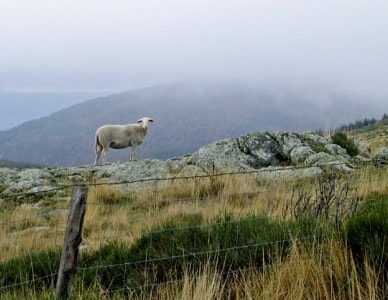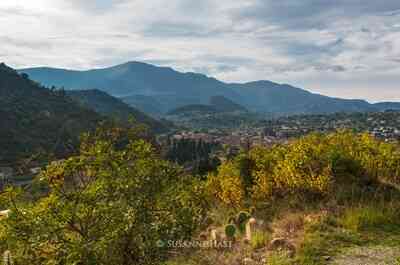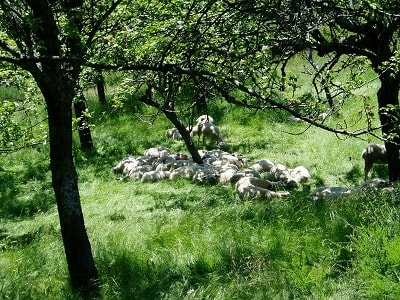Transhumance in Vivarais (Upper-Ardèche) |

 Chambons must regulate the
passage of transhumants through the Bauzon forest that belongs to him. A few rare documents from the 15th century show us the peasants of the lowlands summering their sheep on the high plateaus.
From the 16th century onward, documents multiply to affirm the considerable role of peasant transhumance: herds from the parishes of the lower Vivarais plateaus (Chandolas,
Saint-Alban-sous-Sampzon, etc.) or from the lower Cevennes (Joannas, Lablachère, etc.) move up in the summer to the region of Saint-Etienne-de-Lugdarès; those from Jaujac, in the heart of the Cevennes,
go to spend the summer towards La Chapelle-Grailhouse. These movements amplified in modern times, partly because monastic herds had to be seriously reduced after the Hundred Years' War, which led to the decline
of monasteries, completed by the wars of religion, so that by the 18th century the abbey of Mazan had only 800 sheep left, and partly because the monasteries renounced direct exploitation:
in 1781, Mazan welcomed foreign herds for a fee.
Chambons must regulate the
passage of transhumants through the Bauzon forest that belongs to him. A few rare documents from the 15th century show us the peasants of the lowlands summering their sheep on the high plateaus.
From the 16th century onward, documents multiply to affirm the considerable role of peasant transhumance: herds from the parishes of the lower Vivarais plateaus (Chandolas,
Saint-Alban-sous-Sampzon, etc.) or from the lower Cevennes (Joannas, Lablachère, etc.) move up in the summer to the region of Saint-Etienne-de-Lugdarès; those from Jaujac, in the heart of the Cevennes,
go to spend the summer towards La Chapelle-Grailhouse. These movements amplified in modern times, partly because monastic herds had to be seriously reduced after the Hundred Years' War, which led to the decline
of monasteries, completed by the wars of religion, so that by the 18th century the abbey of Mazan had only 800 sheep left, and partly because the monasteries renounced direct exploitation:
in 1781, Mazan welcomed foreign herds for a fee.
At the beginning of the 19th century, foreign herds came in such quantities to the high plateaus that they worried the mountain dwellers: under the Empire, in Sagnes as in Cros-de-Géorand, mayors complained about these too numerous foreign herds that devoured all the grass and even the genêts essential for roofing houses. It was at this time that herds from Gard, wintering between Alès and Nîmes and even from Vaucluse (Monteux), began to arrive, reinforcing the classic Vivarais transhumance. The first part of the 19th century, the peak of rural settlement, was undoubtedly also the peak of sheep transhumance, which each summer pushed most of the animals from the Cevennes valleys of Ardèche, Lignon, Beaume, Drobie, and the more eastern limestone plateaus to the high plateaus, in addition to the large contingents from Gard and Vaucluse. Thus, the small municipality of Loubaresse, across its 900 hectares, welcomed in 1840, 1,700 foreign sheep, which were added to the 500 natives for the 3 to 4 months of the beautiful season. However, it is difficult to know the exact number of summering animals at that time: some texts indicate more than 100,000 heads, and this is not impossible, as the heaths could host 3 to 4 heads per hectare. Moreover, one must also add 40,000 native sheep.
 All the high plateaus
were more or less involved. On the plateau of Saint-Agrève, already very northern, only the municipality of Devesset was affected, due to the ancient possessions of the Hospitallers:
the tradition was maintained after the Revolution, as in 1837, Devesset welcomed more than 3,000 sheep, mainly from Provence. The surroundings of Mézenc, from Mézilhac to Estables
and to the nascent Loire, also welcomed many, as documents from the 18th century report, and they came from far away, from Gard and Vaucluse. However, further south,
between the Loire and the Allier, there has always been, around the heights of Tanargue, the summer kingdom of transhumants. Here, indeed, the vast grassy heaths suitable for sheep
roll, and most of them have remained the property of many hamlets, easy to rent to foreign shepherds. The mountain communities primarily lived from rye cultivation, associated
with modest breeding of horned and wool-bearing livestock, but the inability to feed a large herd in winter, due to lack of hay meadows, prevented them from owning large wooly stocks
capable of benefiting from the abundance of summer grass. Now, surplus sheep were even more appreciated as they could provide essential manure for rye fields, following carefully
established modalities.
All the high plateaus
were more or less involved. On the plateau of Saint-Agrève, already very northern, only the municipality of Devesset was affected, due to the ancient possessions of the Hospitallers:
the tradition was maintained after the Revolution, as in 1837, Devesset welcomed more than 3,000 sheep, mainly from Provence. The surroundings of Mézenc, from Mézilhac to Estables
and to the nascent Loire, also welcomed many, as documents from the 18th century report, and they came from far away, from Gard and Vaucluse. However, further south,
between the Loire and the Allier, there has always been, around the heights of Tanargue, the summer kingdom of transhumants. Here, indeed, the vast grassy heaths suitable for sheep
roll, and most of them have remained the property of many hamlets, easy to rent to foreign shepherds. The mountain communities primarily lived from rye cultivation, associated
with modest breeding of horned and wool-bearing livestock, but the inability to feed a large herd in winter, due to lack of hay meadows, prevented them from owning large wooly stocks
capable of benefiting from the abundance of summer grass. Now, surplus sheep were even more appreciated as they could provide essential manure for rye fields, following carefully
established modalities.
 It is in the 19th century, due to the abundance of documentation, that we can best know the life of transhumants and their insertion into the economic and social system
of the high Vivarais plateaus, but the analyzed situation should not differ much from previous centuries, as this mode of breeding relies on time-honored customs.
A simple difference, formal by the way: the herds now all belong to people from the lowlands, while in the past immense squads were the property of the monks of the highlands.
The herds are now small: 200 to 500 heads per flock, and they belong to farmers, not specialists. Two ways to proceed. The first consists of grouping the animals of one village or even
several to form the "parjade" or transhumance herd, under the leadership of a shepherd designated by the community: this is the system of the common shepherd applied to summer grazing,
which is the rule in the cantons of Joyeuse and Valgorge. In the second case, it is a summer grazing contractor who takes care, for a fee, of bringing the animals entrusted to him: thus,
in the canton of Thueyts, the animals are marked at departure, and the shepherd receives from each an agreed price for the summer, which was already the rule in the 17th century.
It is in the 19th century, due to the abundance of documentation, that we can best know the life of transhumants and their insertion into the economic and social system
of the high Vivarais plateaus, but the analyzed situation should not differ much from previous centuries, as this mode of breeding relies on time-honored customs.
A simple difference, formal by the way: the herds now all belong to people from the lowlands, while in the past immense squads were the property of the monks of the highlands.
The herds are now small: 200 to 500 heads per flock, and they belong to farmers, not specialists. Two ways to proceed. The first consists of grouping the animals of one village or even
several to form the "parjade" or transhumance herd, under the leadership of a shepherd designated by the community: this is the system of the common shepherd applied to summer grazing,
which is the rule in the cantons of Joyeuse and Valgorge. In the second case, it is a summer grazing contractor who takes care, for a fee, of bringing the animals entrusted to him: thus,
in the canton of Thueyts, the animals are marked at departure, and the shepherd receives from each an agreed price for the summer, which was already the rule in the 17th century.
 The departure took place
in the first half of June and the return in the first half of September, so the stay in the mountains lasted about a hundred days. The journeys were made along the
ancient paths, the famous drailles, wide paths 12 to 20 meters wide, true corridors for herds. There were three main ones: the one leading from Saint-Ambroix and Les Vans
to the heights of Tanargue via Montselgues, Loubaresse, and Le Bez; the one that took the valley of the Ardèche and the Chavade pass; and finally the one that, starting from the low Vivarais plateaus,
climbed to Saint-Laurent-en-Coiron, the Escrinet pass, and continued to Gerbier and Mézenc. It is this path that in 1337 the sheep of Mazan took from the barns of Berg to Montlaur,
which required an agreement with the lord of Montlaur to regulate the right of passage. And in 1905, 6,000 sheep were still seen passing in 28 parjades, a fine example of longevity.
The departure took place
in the first half of June and the return in the first half of September, so the stay in the mountains lasted about a hundred days. The journeys were made along the
ancient paths, the famous drailles, wide paths 12 to 20 meters wide, true corridors for herds. There were three main ones: the one leading from Saint-Ambroix and Les Vans
to the heights of Tanargue via Montselgues, Loubaresse, and Le Bez; the one that took the valley of the Ardèche and the Chavade pass; and finally the one that, starting from the low Vivarais plateaus,
climbed to Saint-Laurent-en-Coiron, the Escrinet pass, and continued to Gerbier and Mézenc. It is this path that in 1337 the sheep of Mazan took from the barns of Berg to Montlaur,
which required an agreement with the lord of Montlaur to regulate the right of passage. And in 1905, 6,000 sheep were still seen passing in 28 parjades, a fine example of longevity.
It was undoubtedly a colorful and noisy spectacle that unfolded in June and September along these ancient paths. However, it has often been described. We will only say that the ram, leader of the flock, wore, embedded in its collar, fetish stones designed to protect the animals from diseases and misfortunes, as this "peyrrassou" appears as a testimony to the antiquity of pastoral practices related to transhumance. In any case, life in the mountains obeyed a certain number of precise rules that were often codified in contracts regarding the use of pastures. Except, indeed, for the case of monastic herds, the shepherds owned nothing on the heights. Therefore, the land had to be rented. Around Tanargue, in the mid-19th century, the rental price of common lands was set at 5 francs per hectare for 3 to 4 sheep per hectare. In some cases, the fee could be lower. Thus, on the estate of Villevieille, an old farm of the Chartreux near Mézenc, one received 1,000 to 1,500 sheep for three months for only a few sols per head, as these sheep grazed on the refuse of horned livestock and ensured the fertilization of the meadows. Similarly, in 1862, all the common pastures of La Chapelle Grailhouse were leased to a shepherd from Jaujac who brought 400 ewes in exchange for only the fertilization of private lands and the care of 100 local woolly livestock. In return, the inhabitants fed the shepherd and his dogs.
 The most remarkable custom was that of the nights of manure, attested since the 13th century, and still in force in the 20th century, as shown by a lawsuit in 1923 involving residents
of the hamlet of Masméjan (commune of Saint-Etienne de Lugdarès) concerning the distribution of the proceeds from these nights of manure, which stemmed from a document of the abbey of Chambons dated May 17, 1457. The
sheep had to sleep at night in pens on the fallow fields of private individuals, who paid a fee to the shepherd for this purpose, spending the night in a simple hut called a
"chabotte." Thus, there existed a close symbiosis between foreign pastoral life and mountain agriculture.
The most remarkable custom was that of the nights of manure, attested since the 13th century, and still in force in the 20th century, as shown by a lawsuit in 1923 involving residents
of the hamlet of Masméjan (commune of Saint-Etienne de Lugdarès) concerning the distribution of the proceeds from these nights of manure, which stemmed from a document of the abbey of Chambons dated May 17, 1457. The
sheep had to sleep at night in pens on the fallow fields of private individuals, who paid a fee to the shepherd for this purpose, spending the night in a simple hut called a
"chabotte." Thus, there existed a close symbiosis between foreign pastoral life and mountain agriculture.
 Transhumance began to decline after 1870, as economic conditions evolved. In Devesset, the sale of common lands harmed the transhumants, who, from more than 3,000 at the end of the 18th century,
dwindled to 500-600 a century later, disappearing before 1914. In Loubaresse, reforestation by the Water and Forests Authority after 1877 dealt a fatal blow to transhumance.
Especially, rye cultivation was in significant decline, and fertilization by foreign sheep was no longer of interest. In the lowlands, for various reasons, sheep herds disappeared.
At the beginning of the 20th century, transhumance had certainly decreased by half, carrying hardly more than 40,000 to 50,000 heads. By 1930, there were barely 20,000 counted, mainly concentrated around Tanargue.
Twenty years later, only about a dozen herds from Gard came, just over 3,000 sheep. Since then, transhumance on the high Vivarais plateaus has completely disappeared. From this overview of 7
centuries of transhumance on this eastern edge of the Central Massif, we can draw some conclusions.
Transhumance began to decline after 1870, as economic conditions evolved. In Devesset, the sale of common lands harmed the transhumants, who, from more than 3,000 at the end of the 18th century,
dwindled to 500-600 a century later, disappearing before 1914. In Loubaresse, reforestation by the Water and Forests Authority after 1877 dealt a fatal blow to transhumance.
Especially, rye cultivation was in significant decline, and fertilization by foreign sheep was no longer of interest. In the lowlands, for various reasons, sheep herds disappeared.
At the beginning of the 20th century, transhumance had certainly decreased by half, carrying hardly more than 40,000 to 50,000 heads. By 1930, there were barely 20,000 counted, mainly concentrated around Tanargue.
Twenty years later, only about a dozen herds from Gard came, just over 3,000 sheep. Since then, transhumance on the high Vivarais plateaus has completely disappeared. From this overview of 7
centuries of transhumance on this eastern edge of the Central Massif, we can draw some conclusions.
Transhumance is linked, on one hand, to the agricultural predominance of the Vivarais mountains (or incidentally to cattle breeding around Mézenc) and, on the other hand, to the abundance of heaths, which farmers could hardly take advantage of, not knowing what to do with their sheep in winter. Transhumance provided them with cheap fertilizer. This is a peculiar phenomenon in the Central Massif, and it is not found in mountains rich in alpine pastures like the Alps. Here, it reached its extreme northern peak in Devesset, as, due to the opening of the Rhône Valley, Mediterranean conditions rise northward, up to Coiron, and the uplift of the Central Massif, here at its maximum, offers, at very short distance, high-altitude pastures. In the Middle Ages, monasteries located on the heights organized a descending transhumance over short distances that would last, albeit diminishing, until the Revolution. But it coexisted with an ascending transhumance of small peasant herds. This latter took precedence from the beginning of the Modern Era, due both to the decline of monasticism and the demographic growth that accelerated in the 18th century.
Former holiday hotel with a garden along the Allier, L'Etoile Guest House is located in La Bastide-Puylaurent between Lozere, Ardeche, and the Cevennes in the mountains of Southern France. At the crossroads of GR®7, GR®70 Stevenson Path, GR®72, GR®700 Regordane Way, GR®470 Allier River springs and gorges, GRP® Cevenol, Ardechoise Mountains, Margeride. Numerous loop trails for hiking and one-day biking excursions. Ideal for a relaxing and hiking getaway.
Copyright©etoile.fr